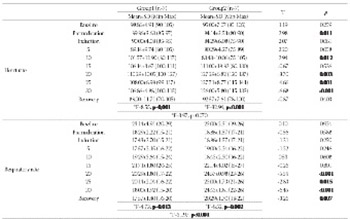Comparison of ketamine-diazepam with ketamine-xylazine anesthetic combinations in sheep spontaneously breathing and undergoing maxillofacial surgery
DOI:
https://doi.org/10.17305/bjbms.2010.2675Keywords:
anesthesia, general, oral surgical procedures, xylazineAbstract
The objective of this study was to choose a suitable anesthetic combination for use in experimental surgical models by comparing the anesthetic and cardio-respiratory changes. Fourteen healthy male sheep were randomly assigned to two different drug regimens. In Group 1 the sheep were anesthetized with ketamine + xylazine (22 mg/kg im. + 0.2 mg/kg i.m., respectively). Anesthetic combination of ketamine + diazepam (22 mg/kg im. + 0.4 mg/kg i.m., respectively) was used in Group 2. Heart rate, respiratory rate and mean arterial pressures were evaluated before anesthesia, after induction of anesthesia up to 30 minutes in 5 minute intervals and during recovery. In all sheep, duration of anesthesia induction, duration of anesthesia and duration of recovery were recorded. Quality of induction, anesthesia, analgesia and recovery were evaluated. Cardio-respiratory parameters decreased below baseline values after anesthesia induction in both groups. However, no profound effects on cardio-respiratory functions were observed during study. In Group 2, it was observed that; anesthesia induction time was longer, the depth of anesthesia was inadequate during the osteotomy stage of the surgical procedure and recovery time was longer in comparison to Group 1. Otherwise the quality of anesthesia induction, anesthesia, analgesia and recovery was better in Group 1 than Group 2. These findings indicate that both drug combinations can provide short time anesthesia for minor surgical procedures. Ketamine+xylazine combination can be used as a more suitable anesthetic combination in experimental surgical procedures such as maxillofacial surgery than ketamine+diazepam combination, in sheep.
Downloads














